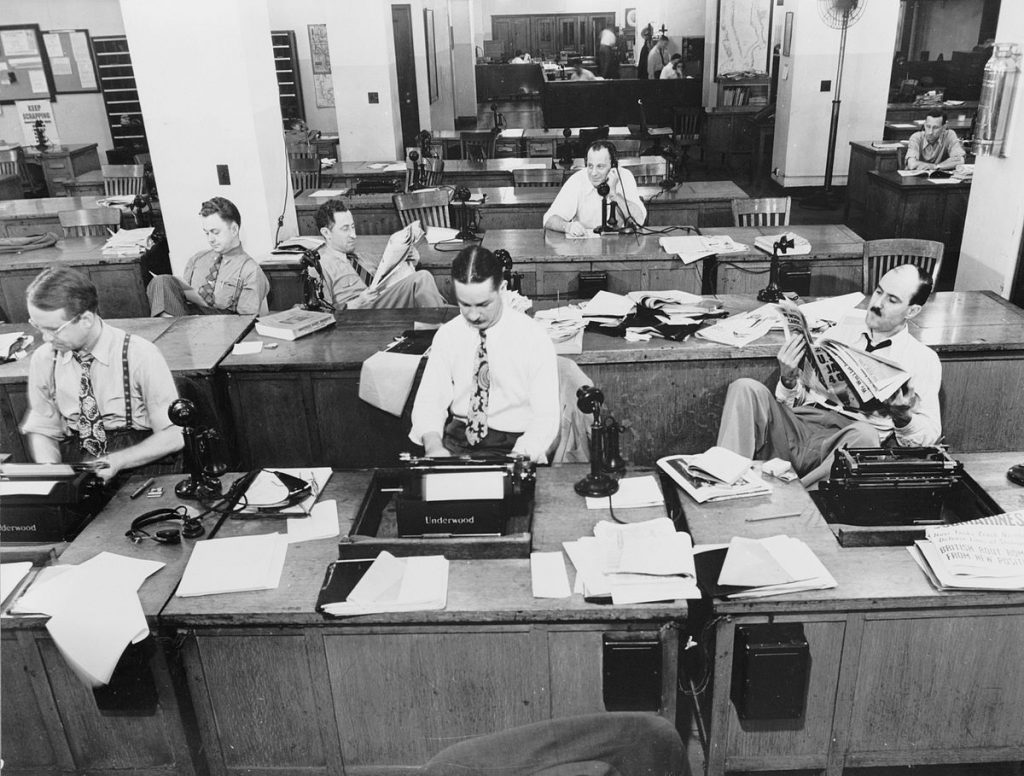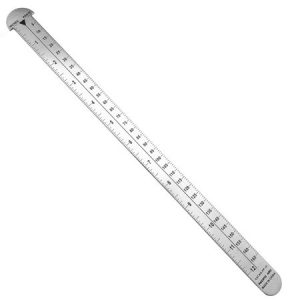
UPDATE, Nov 5: see a new entry – cock-up – below, brought to Glosso’s attention on our Facebook page.
~~~
The world of journalism is changing — fast. Not just in terms of who is writing (or no longer writing) about what on which platform or outlet: it’s how and by what means the words travel logistically from the writer’s mind to the reader’s eye. And along with that shifting means of transport comes a whole new constantly-changing language. Let’s take a nostalgic journey back to the old-fashioned days of journalism when red pens, paper galleys, metal rules, fax and telex machines, telephones and glue sticks ruled the newsroom. Some of the old jargon from that time still floats around today, but mainly only in the dusty minds of us old scribes and subs …
Above the fold – A broadsheet paper folded in half for display. The top half of the page, above the fold, is held to be the most important real estate in the paper. A reporter’s ambition is to get an article on the front page; a reporter’s supreme ambition is to get that article above the fold. (courtesy of John E McIntyre)
Add – Copy to be added to a story already written.
All caps – A word or sentence written in all capital letters
Bang out – A composing room ritual in which an employee leaving the premises for the last time is commemorated by the pounding of pica poles against metal surfaces in a commemorative clamor. (courtesy of John E McIntyre)
Buried lede – The central element of an article mistakenly appearing deep in the text. It must be disinterred. (courtesy of John E McIntyre)
Cap – Upper case.
Chaser – A page or set of pages typeset after the formal edition close to attempt to get breaking news into the paper. (courtesy of John E McIntyre)
Chief sub – Much like a slot editor (see below), the head of a desk of sub-editors, often sitting at the center of a U-shaped desk.
Cock-up – Printing. Having the top much above the top line of the other letters: applied to a large type used for an initial of a book or part. 1838 C. H. Timperley Printers’ Man. “The first word…is generally put in small capitals, either after a capital of its own body, or one of a larger size, called a cock-up letter.” (Oxford English Dictionary)
Cold type – Headlines and text produced on photographic paper and pasted up in a composing room. Increasingly supplanted by electronic transmission of pages directly to a printing plant, where the pages emerge as metal plates to go on the printing press. (courtesy of John E McIntyre)
Copy editor – An anonymous drudge who attempts, against great odds, to correct the many faults of writers before publication. Extinction imminent. (courtesy of John E McIntyre)
Coverline – Captions on a magazine cover.
CQ – An indication that the name or term so noted has been checked and verified. Copy editors, whose suspicions are well founded, often suspect that reporters use CQ to indicate “better check this”. (courtesy of John E McIntyre)
Crosshead – A few words used to break up large amounts of text, normally taken from the main text. Typically used in interviews.
Dateline – A line at the beginning of a story stating the date and the location.
Deck – Part of the headline that summarizes the story. Also known as “deck copy” or “bank.”
DPS – Double-page spread; can also be referred to as a spread.
Em-rule – A nickname for a pica pole used by sub-editors at the BBC in the 1980s (and perhaps before).
Endnote – Text written at the end of an article stating the author’s credentials.
Flatplan – A page plan that shows where the articles and adverts are laid out.
Get (n)– A very good or exclusive interview.
Glossite – The website of a glossy women’s magazine.
Goat-choker – An article of inordinate and suffocating length, produced to gratify the vanity of the author and the aspirations of the publication. (courtesy of John E McIntyre)
Graf – Paragraph. (courtesy of John E McIntyre)
Gregg – A type of shorthand.
Hack (m) /hackette (f) – Derogatory alternative to journo.
Hed – A headline, giving rise to the abbreviation HTK, for head to come, an article transmitted in a take or takes before it is in final form.
Jumpline – A line indicating a continuation — or jump — of an article on a subsequent page. Though readership surveys for generations have indicated that readers despise jumps and generally do not follow them, it does not suit newspapers to do otherwise. (courtesy of John E McIntyre)
Kicker – The first sentence or first few words of a story’s lead, set in a font size larger than the body text of the story.
Lede – The phonetic spelling of lead, the beginning, usually the first paragraph, of an article, so spelled as to indicate the specialized meaning rather than the common meaning to a Linotype operator. (courtesy of John E McIntyre)
Legacy media — An umbrella term to describe the centralized media institutions that were dominant during the second half of the 20th century, including — but not limited to — television, radio, newspapers and magazines, all which generally had a uni-directional distribution model. Sometimes “legacy media” is used interchangeably with “MSM,” for “Mainstream Media.” Legacy media sits in contrast with social media, where the production and sharing is of equal weight to the consumption. (Courtesy of Hacks/Hackers Survival Glossary)
Lobster shift – Working in the hours after a publication has gone to print. Also known as “dog watch.”
Martini media – Media that is available “any time, any place, any where”.
Nut graf – Paragraph containing the essential elements of a story.
Off diary – An unscheduled or unpredicted story. On diary – Scheduled story.
Orphan – First line of a paragraph appearing on the last line of a column of text. Normally avoided.
Pasteup – The assemblage of pages by pasting type onto page mock-ups, which are then photographed to be made into metal plates for the printing press. (courtesy of John E McIntyre)
Pica pole (also known as a line gauge, a pica stick, and nowadays as a gaebel ruler) – A metal ruler used by printers in the composing room to measure type by picas (12 points to the pica, six picas to the inch). The pica pole is pounded against a metal surface in the ritual of banging out an employee leaving the premises for the last time. (courtesy of John E McIntyre)
Pittman – A type of shorthand.
Pork – Material held for later use, if needed.
Rags – The irregular or uneven vertical margin of a block of type.
Recto – Right-hand page.
Redletter – Exclusive, breaking news coverage of a major news event, printed in red type.
Rim editor – A copy editor, a nonentity. (courtesy of John E McIntyre)
Sacred cow – News or promotional material which a publisher or editor demands be published, often for personal reasons.
Slot editor – On a copy desk, the copy editor who checks and corrects the copy of other copy editors before approving it for publication. The term arises from the obsolete furniture of the newsroom, where once a horseshoe-shaped desk enabled the slot editor to hand out paper copy to the copy editors on the rim, the outside of the horseshoe. To slot (v.) is to check an article that has been copy edited before approving it for typesetting. (courtesy of John E McIntyre)
Spike – n. The spindle on which paper copy that was not to run was impaled, giving rise to the verb to spike, “to kill a story”. (courtesy of John E McIntyre)
Standfirst – Line of text after the headline that gives more information about the article.
Stet – (From the Latin) Let it stand; let the original copy go as written. The hardest word for a copy editor to use. (courtesy of John E McIntyre)
Strapline – Similar to a subhead or standfirst, but used more as a marketing term.
Sub-editor – The person that checks and edits a reporters’ work and adds headlines and standfirsts.
Subhead – A smaller one-line headline for a story.
Take – A section of an article. An article that is transmitted to the copy desk or the composing room as it is being written is sent in takes. (courtesy of John E McIntyre)
Teeline – A form of shorthand.
Telegraph section – The section in which national and foreign news was acquired by telegraph in the remote past. The copy was edited on the telegraph desk, a component of the copy desk. (courtesy of John E McIntyre)
Thirty – A numeral indicating the conclusion of a take of copy. (courtesy of John E McIntyre)
TK – Proofreader’s insertion mark for data to come. Sometimes written as TKTK.
Tombstoning – In page layout, to put articles side by side so that the headlines are adjacent. The phenomenon is also referred to as bumping heads. (courtesy of John E McIntyre)
Top heads – Headlines at the top of a column.
Verso – Left-hand page.
Widow – Last line of paragraph appearing on the first line of a column of text.
Wob – White text on a black or other colored background.
Most of the definitions above are courtesy of Journalism.co.uk — and a few are from my memories of working at the BBC as a sub-editor and chief sub many moons ago.
***


In typeset printing the origin of “cock-up” does indeed refer to the the capital letter of the first word in a paragraph. However, it became common usage to denote an error when a mid-paragraph letter was set incorrectly, i.e. with its top above the line of the rest of the letters. The person checking the Type-Setter’s work might say something like “you’ve got a cock-up in the middle of the third word on the second line”.
Thank you, Robert. I had no idea. I think the word “cock-up” might deserve its own Glossophilia post …
– Louise/Glosso
One term that seems to be missing here is ‘byline’. This is often misunderstood by the general public who think it means something like ‘panel’ or ‘sidebar’.
In fact, a byline is the line of text that tells you who wrote the story. Below the headline and above the standfirst, often in its own little box, is the line: ‘by Nicholas Whitehead’ or whoever the reporter is. That’s a byline. Reporters love bylines because they enhance their reputation and improve their chances of getting a better job. If you write a better story than a rival newspaper, it helps if the bosses of that rival paper know who wrote it.
Wanted to add that “30” should be “-30-“ ( dash thirty dash) indicating the end, not the numeral 30.
Adding a few more:
“Wood” Getting the wood is even better than your story being placed above the fold, unless the wood is “Dewey Beats Truman.”
“Morgue” The tangible research archive of a newspaper
“Dummy” The pre-publication mock-up of the paper.
what do the composing room jargon gh and nf mean